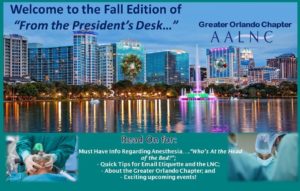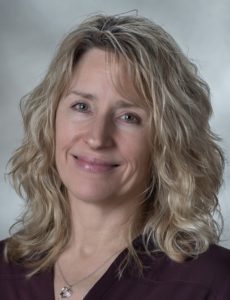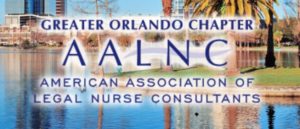
Who’s at the Head of the Bed?
by
Michelle Gaines, MNA, RN, CRNA
You are scheduled for surgery. Someone from the anesthesia department calls you and reviews your history and answers your questions. The day of surgery you are greeted at the bedside by a professional anesthesia provider who asks you questions about your medical history and explains the anesthesia care. That person may even administer a preoperative regional block, if indicated. As you are wheeled into the operating room you feel comfortable that the same person is going to be with you throughout your anesthesia and surgical experience. It makes for a nice story, but it is seldom the case that from preoperative evaluation to recovery room, you will be cared for by just one individual.
Anesthesia in the United States is practiced under several different care models. Geographic location, urban versus rural, local custom, and availability of providers all comes into play as to which care model is practiced. It could be an anesthesiologist in solo practice. The care team model most prevalent is an anesthesiologist and several certified registered nurse anesthetists, (CRNAs). Depending on state laws it could be an anesthesiologist with both nurse anesthetist and certified anesthesia assistants (CAAs) providing care. In rural America CRNAs represent more than 80 percent of anesthesia provided.
Most people are aware that an anesthesiologist can be either an MD or a DO that has completed a residency to become board certified as an anesthesia provider. Some continue in a fellowship and practice in very specialized anesthesia practices such as cardiac or pain management. Certified registered nurse anesthetists (CRNAs) have a hundred- and fifty-year history, beginning with nuns who staffed the operating rooms. They were hand-picked by surgeons who told them what they needed to be doing to help the patient during surgery. The CRNA credential came into existence in 1956.(1)
In 1982 the tax, equity, and fiscal responsibility Act (TEFRA) was enacted into federal law and changed the way payment was tracked and processed for everyone in anesthesia.(2) In 1986 CRNAs were the first nursing specialty to get direct reimbursement from Medicare. In 2001 the Centers for Medical and Medicaid Services (CMS) changed the federal physician supervision rule for nurse anesthetist to allow state governors to opt out of this facility reimbursement requirement.(3)
In 2010, the institute of medicine (IOM) analyzed the need for supervision and concluded that Advanced Practice Nurses should be allowed to practice to the greatest extent of their training and education.(4) In 2014 the Cochrane collaboration found no difference in safe patient care between nurse anesthetist and physician anesthesiologist.(5) By holding a national certification and nursing license as an advanced practitioner, CRNAs can practice independently.
Due to severe acute staffing shortages and a greater need of versatile critical care providers during the COVID-19 surge, in March 2020, the CMS emergently waived the requirement for physician supervision for reimbursement, allowing states to maximize their healthcare workforce.(6) CRNAs with their background in ICU care, played an important role in the management of critically ill ventilated patients. CRNAs are often in the leadership position during code blue situations. Current graduates of nursing programs can graduate with a doctorate in anesthesia. The profession now requires CRNAs to reboard every eight years to assure competency in the ever-changing knowledge base of anesthesia care. CRNAs practice with a high degree of autonomy and are qualified to make independent judgements in all aspects of anesthesia care based on their education, licensure, and certification. Licensure from the state, hospital privileges and local customs drive the practice models.
Recently the American Association of Nurse Anesthetist (AANA) decide to rename the national association to the American Association of Nurse Anesthesiology. In parsing out the definitions, an anesthetist is one who administers anesthesia, and an anesthesiologist is one who has studied the science of anesthesia. Although this was a national change, state laws vary as to how a nurse can present to the patient. In the state of Texas, the term anesthesiologist is considered a medical doctor and you would be impersonating a doctor if you used that terminology at the bedside with a patient.
Who are anesthesia assistants? Anesthesia Assistants (AA) are often referred to as mid-level providers. They were conceived in the 1960’s by three anesthesiologists. These anesthesiologists wrote, “responsibility and immediate care of the patient must remain in the province of the anesthesiologist; consequently, personnel could not work independently but only under the immediate direction of an anesthesiologist.” (7) In 1969 two AA programs were started, one at Emory university in Atlanta and one at Case Western Reserve in Cleveland Ohio.
The AA model is like the PA model, but they practice only in anesthesiology and are supervised by an anesthesiologist. To date there are twelve AA programs. They are from twenty-four to twenty-eight months long and graduate with a master’s degree. They must pass the National Commission for Certification of Anesthesiologist Assistants (NCCAA) exam, that was first given in 1992. Currently CAAs practice in seventeen states. They are described as having identical clinical capabilities and responsibilities working in the care team model.(8)
In the United States, the care team model is driven by federal reimbursement. One anesthesiologist to four non-physician providers (CAA or CRNA) is the standard in large centers. The terms “medically directed” versus “medically supervised” have distinct differences. These terms are related to billing and reimbursement, not necessarily to how much time an anesthesiologist is involved in patient care.
An understanding of how anesthesia providers are paid, reveals a better understanding of medical direction versus medical supervision. Medicare pays for medical direction of CAAs and CRNAs at 50% for the case. To meet the medical direction requirement of direction of two to four concurrent cases, the anesthesiologist must meet seven TEFRA rules:
- Perform the preanesthetic exam and evaluation.
- Prescribe the anesthetic plan.
- Personally participate in the most demanding procedures in the plan. Typically, induction and emergence.
- Ensure procedures that they do not personally perform, are performed by a qualified individual.
- Monitor the course of the anesthesia frequently.
- Remain physically present and available for immediate diagnosis and treatment of emergencies.
- Provide indicated post anesthesia care.
Medically supervised applies to circumstances where there are more than four concurrent cases. The use of non-physician providers can occur, but billing can only occur for three base units. Anesthesia is billed in 15-minute intervals. Anesthesia conversion factors (ACF) are determined for each locality where anesthesia is performed. A single conversion factor is used for all qualified anesthesia providers, physician or non-physician and is expressed in dollars. The 2023 finalized anesthesia conversion factor is $20.6097 representing a decrease of 4.42% from 2022.(9)
Getting back to the original question, who is at the head of the bed, and how can a legal nurse consultant know by looking at the chart. Look for the preoperative assessment, a required part of the anesthesia record that requires a signature, either electronically or manually. In some outpatient centers it may be located on the anesthesia record itself. Look for the provider list if an electronic medical record is used. If paper charting is being used, still a thing in the anesthesia world, the anesthesia record will have a place for the provider to sign. Compare the anesthesia assessment with the anesthesia record, as providers may change. Also look at the charting of the circulating nurse, they should be documenting the providers and times providers come and go in the operating room. Look for a report given from anesthesia to the post anesthesia care unit (PACU), to see what provider is giving report to the recovery room nurse. This is easier to track with electronic charting. Lastly, find out how the case was billed. If it was billed medically directed, then the anesthesiologist is supposed to be available in a timely manner to guide and assist in any changes from the original care plan, refer to TEFRA rules.
(Sources for this article are included in the Side Bar.)
Michelle Gaines, MNA, RN, CRNA
Secretary, Greater Orlando Chapter of AALNC
__________________________________________________________________________________
CHAPTER MEMBER HIGHLIGHT
ALISON BRANDT, BSN, RN

Alison is the owner of AccuRite Nurse Consulting, LLC, focusing on medical malpractice, personal injury, worker’s comp, wrongful death, and criminal liability, for plaintiff or defense. Her career started over 30 years ago, working outpatient in urgent care, various physician offices and clinics. Moving to inpatient, she worked general med-surg, ortho-neuro, and cardiac ICU step down, where she managed complex, high-acuity patients with multiple comorbidities. For a time in between, she was an OR circulator; she also served as a float nurse in the emergency department. As her final direct patient care run, Alison became a Corrections Nurse. There, she triaged and addressed inmates’ issues in an RN-run clinic for the sick, injured and emergencies. Meanwhile, interested in entering the legal nurse consulting field, Alison completed online certificate coursework and began her LNC journey with a mass tort company, where she developed many related skills. Alison serves both attorney clients and as LNC subcontract-while furthering her LNC education weekly, developing her company and regularly seeking opportunities for expanding and updating her clinical knowledge. She has been a member of the LNC Exchange and AALNC for 3 years, and is now a member of the Greater Orlando and the West Virginia Upper Ohio Valley Chapters of AALNC. This year, Alison attended an LNC residency program and the LNC Annual Forum and completed an Audit Trails certification course. Always striving to improve her skills base, Alison’s main focus continues to be benefiting clients with attentiveness to detail and accuracy, and her strong belief in accountability for quality work and customer service.
__________________________________________________________________________________

EMAIL ETIQUETTE 101 – tips for the LNC
Transitioning from a clinical environment to the nuances of office decorum can be a challenging feat, particularly when navigating the intricacies of email communication. Below, you’ll find seven invaluable guidelines to bear in mind prior to clicking the “send” button.
Begin Each Email with a Greeting: Neglecting to include a salutation may inadvertently convey a sense of impatience or discourtesy to your recipient. This can be especially tricky when time is of the essence!
Embrace Politeness: Remember that your recipient might be grappling with their own set of challenges or difficulties. Don’t take their response, or lack thereof, personally. If a matter becomes personal, opt for a mature phone call to resolve it.
Clarity is Key: Craft a subject line that concisely conveys the nature of your message, which can include the relevant case or case number. For example “Case 1028 – Smith v Smith: Potential Neurology Experts.
Understand Your Audience: Tailor your tone to your audience. When communicating with individuals who may not be familiar with your sense of humor or tendencies toward sarcasm, it’s best to maintain a straightforward and professional tone.
Be Mindful of Discoverability: Keep in mind that all expert correspondence is subject to discovery. If you wouldn’t want your words scrutinized during a deposition, think twice before putting them in writing.
Thorough Reading: Prior to responding, ensure that you’ve read the entire email. Rushed responses can lead to misunderstandings or omissions.
Secure Medical Records: When sending medical records, prioritize security. Utilize encryption or platforms like Dropbox with password protection to safeguard sensitive information.
These seven pointers will not only enhance your email etiquette, but also promote effective and considerate communication in a professional setting.
Alyssa Brandeberry, RN, LNCC
Greater Orlando Chapter of AALNC, Director at Large
_______________________________________________________________________________

LNC PROFESSIONAL DEVELOPMENT
AALNC and Chapters – GoTo Source
AALNC and the Chapters are THE GO TO sources for networking and professional development in the field of legal nurse consulting. Want to learn of career opportunities? Want to stay up to date with the LNC industry trends? Want to hone your LNC skills and learn new ones? Then go to AALNC at https://aalnc.org and join now! Then go to https://orlandoaalnc.org and join our Chapter! And you can join ALL of the AALNC Chapters – for unlimited networking!
WE ARE NEAR YOU! Maybe not geographically, but through your computer or phone. The Greater Orlando Chapter has members in 30 States, Puerto Rico, and Canada! SINCE 2014, The Greater Orlando Chapter’s live Chapter Meetings with CE Programs have been broadcast virtually! Members and guests have been attending from all over the Country since then! Because of COVID, since 2020 all of our CE Programs have been virtual only.
Greater Orlando Chapter Membership Cycle goes from May to May of each year, with membership renewal being May 31. With this cycle, members who joined in 2023, will renew their membership NLT May 31, 2024. CONTACT US:
Email us at: info@orlandoaalnc.org
Or visit us at: https://orlandoaalnc.org
CONNECT WITH US
Connect with us on LinkedIn
Check us out at: https://orlandoaalnc.org
Contact us at: info@orlandoaalnc.org
_______________________
Resources for Who’s at the Head of the Bed?
1. History of AANA. http://www.aana.com/about-us/history/
2. Centers for Medicare & Medicaid Services (CMS) Basic Billing for Anesthesia Services Provided by Anesthesiologist and Certified Registered Nurse Anesthetist, http://www.masscrna.com/assests/docs/chart_cms_basic_billing.pdf
3. CMS Opt-Out States for CRNAs, http://www.crnapaccentral.net>nurse-anesthesiologist.
4. The future of Nursing: Leading Change, Advancing Health, http://www.iom.edu/Reports/2010/ The-Future-of-Nursing-Leading-Change-Advancing-Health.aspx
5. Physician Anesthetist Versus Nurse Anesthetist for Surgical Patients, http://www.cochrane.org/CD010357/ANAESTH_physician-anaesthetists-versus-nurse-anaesthetist-for-surgical-patients
6. 2020-03-31-MLNC-SE, http://www.cms.gov>2020-03-31-mlnc-se
7. History of the Profession- Emory School of Medicine, https://med.emory.edu/departments/anesthesiology/education/masters/program/history.html
8. Anesthesiologist Assistants, https://www.asahq.org/advocacy-and-asapac/advocacy-topics/anesthesiologist-assistant
9. American Society of Anesthesiologists, https://www.asahq.org/advocacy-and-asapac/fda-and-washington-alerts/washington-alerts/2022/11/cms-provides-little-relief-for-anesthesia-groups-in-release-of-2023-payment-rules
_____________________________

Be sure to check out our new publication, “SAVE THE DATES.” This new publication includes LNC education programs offered by AALNC, and ALL of the AALNC Chapters! We are so excited for this joint Chapter activity! Watch for the next edition, coming to your inbox in early 2024! In the meantime:
1. Watch for our announcement for our January 16, 2024, Annual Meeting and Officer Inauguration.
2. Check out our On-Demand Webinars. We have 15 On-Demand Webinars which are free for Chapter members and only $15 for non-Chapter members.
3. And check out the 2024 education programs from our fellow AALNC Chapters:
a. Bay Area Chapter of Northern California at: https://www.bacnc.org/
b. New Jersey Chapter at: https://njaalnc.org/
c. Pittsburgh Chapter at: https://aalncpittsburgh.org/
d. Tampa Bay Chapter at: https://tbaalnc.org/
e. West Virginia Upper Ohio Valley Chapter at: https://wvuov-aalnc.com/
f. And the BRAND NEW Pacific Northwest Chapter at: https://www.pnw-aalnc.com/
The Greater Orlando Chapter is working on the 2024 Webinar series, and has some VERY exciting presentations coming up! Check our website soon, for these upcoming LNC education offerings!
AND, if you have not already done so, REGISTER NOW for AALNC Forum 2024 in Pittsburgh! And you don’t want to miss Pre-Forum which will be a Mock Trial – with Jury! Wow!
The Greater Orlando Chapter of AALNC is an approved provider of Nursing CE through the Florida Board of Nursing and CE Broker, and approved by the following States: Arkansas, District of Columbia, Florida, Georgia, Kansas, Kentucky, Mississippi, New Mexico, South Carolina and West Virginia. We report CE directly to CE Broker in these states. For attendees from other States, we provide required documents for self-reporting CE to State Boards of Nursing.
___________________________
LNC LAUNCHPAD – Q&A with Greater Orlando Chapter LNCs

In 2021 we started a new program for members, which we call “LNC Launchpad – Q&A with Greater Orlando Chapter LNCs.” This is a 1.5 hour session to provide guidance, answer questions, and suggestions. We limit the event to 10 participants, so we can mentor each attendee – whether new to the LNC practice or experienced and ready for a change – we are there for you! The 2024 dates have been selected and registration for the February 13, 2024 session will open around the end of January.
1) February 13, 2024
2) May 14, 2024
3) September 10, 2024
4) November 12, 2024
__________________________
MEET THE 2023 GREATER ORLANDO CHAPTER OFFICERS AND DIRECTORS

President: Tory Palivoda, BS, RN, LNCC
President Elect: Robin Axtell, BSN, RN, LNCC
Immediate Past President: Jillian Talento, BSN, RN, CEN, LNCC
Secretary: Michelle Gaines, MNA, RN, CRNA
Treasurer: Patty Mitchell, BSN, RN, CLNC
DAL: Alyssa Brandeberry, RN, LNCC
DAL: Kenyetta Christmas, MSN, RN, ACNP-BC, CLNC
DAL: Judy A. Young, MSN, MHL, RN, LNCC
____________________________

ABOUT THE GREATER ORLANDO CHAPTER OF AALNC
The American Association of Legal Nurse Consultants (AALNC) was founded in 1989, as a not for profit membership organization dedicated to the professional enhancement and growth of registered nurses practicing in the specialty of legal nurse consulting. Chapter development quickly followed. The Orlando community was rich with nurses already practicing in the field of legal nursing. This group of committed professionals quickly became members of the new national organization and recognized the need for a local chapter. The Greater Orlando Chapter of AALNC, founded in 1989, was the second chapter formed under the new national organization. The Chapter was begun in support of AALNC’s mission, by providing networking opportunities, mentoring and support to nurses through professional development and education – a mission that is continued to this day.
_____________________________

